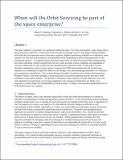| dc.contributor.author | Putbrese, Benjamin L. | |
| dc.contributor.author | Hastings, Daniel E | |
| dc.contributor.author | La Tour, Paul Alexis | |
| dc.date.accessioned | 2018-10-11T15:28:37Z | |
| dc.date.available | 2018-10-11T15:28:37Z | |
| dc.date.issued | 2016-10 | |
| dc.date.submitted | 2015-05 | |
| dc.identifier.issn | 0094-5765 | |
| dc.identifier.uri | http://hdl.handle.net/1721.1/118431 | |
| dc.description.abstract | The space industry is currently at a significant inflection point. Over the past decades, many spacecraft at geosynchronous orbit have continued a trend towards increasingly massive and longer-lasting satellites, and while they do represent some of the most exquisite, highest-performing satellites ever launched, some experts now feel that such trends are unsustainable and are beginning to place increasing strain on the underlying industry. To support current and future spacecraft, on-orbit servicing (OOS) infrastructures have been proposed, which would provide services such as repair, rescue, refueling, and upgrading of customer spacecraft in order to alleviate the identified space industry trends. In this paper, system dynamics modeling is used to assess various scenarios for OOS incorporation into the overall space industry, by evaluating its long-term effects on the design, cost, and underlying experience of a reference geosynchronous constellation. This system dynamics model is based heavily in behavioral economics’ Prospect Theory, with such concepts as anchoring and loss aversion factoring heavily into the overall simulation of the space industry. The primary conclusion of this analysis was that relatively low costs and substantial incorporation of servicing capabilities into customer architectures are likely to be necessary to ensure long-term sustainability of such a project. Finally, several policy implications for an OOS infrastructure are outlined. Keywords: On-orbit servicing; System dynamics; Satellite technology | en_US |
| dc.description.sponsorship | United States. Department of Defense (Contract FA8721-05-C-0002) | en_US |
| dc.language.iso | en_US | |
| dc.publisher | Elsevier | en_US |
| dc.relation.isversionof | http://dx.doi.org/10.1016/j.actaastro.2016.07.007 | en_US |
| dc.rights | Creative Commons Attribution-NonCommercial-NoDerivs License | en_US |
| dc.rights.uri | http://creativecommons.org/licenses/by-nc-nd/4.0/ | en_US |
| dc.source | Prof. Hastings via Barbara Williams | en_US |
| dc.title | When will on-orbit servicing be part of the space enterprise? | en_US |
| dc.type | Article | en_US |
| dc.identifier.citation | Hastings, Daniel E. et al. “When Will on-Orbit Servicing Be Part of the Space Enterprise?” Acta Astronautica 127 (October 2016): 655–666 © 2016 IAA | en_US |
| dc.contributor.department | Massachusetts Institute of Technology. Engineering Systems Division | en_US |
| dc.contributor.approver | Hastings, Daniel E | en_US |
| dc.contributor.mitauthor | Hastings, Daniel E | |
| dc.contributor.mitauthor | La Tour, Paul Alexis | |
| dc.relation.journal | Acta Astronautica | en_US |
| dc.eprint.version | Author's final manuscript | en_US |
| dc.type.uri | http://purl.org/eprint/type/JournalArticle | en_US |
| eprint.status | http://purl.org/eprint/status/PeerReviewed | en_US |
| dspace.orderedauthors | Hastings, Daniel E.; Putbrese, Benjamin L.; La Tour, Paul A. | en_US |
| dspace.embargo.terms | N | en_US |
| dc.identifier.orcid | https://orcid.org/0000-0003-4421-5110 | |
| dc.identifier.orcid | https://orcid.org/0000-0001-6275-2513 | |
| mit.license | PUBLISHER_CC | en_US |
